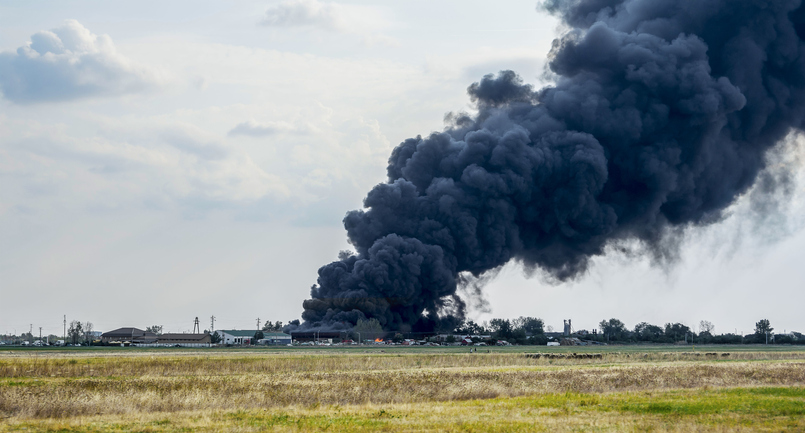
A decade after the deadly Imperial Sugar explosion near Savannah, Georgia that tragically killed 14 people and injured dozens more, combustible dust continues to threaten and take the lives of workers at plant, refineries and other industrial facilities throughout the country.
Imperial Sugar Refinery Explosion: “Walking into Hell”
A massive explosion at the Imperial Sugar refinery rocked the small town of Port Wentworth, Georgia, around 7:00 p.m. on February 7, 2008.
“Thick concrete floors heaved up and brick walls were blown into stairwells and work areas, blocking many exit routes,” according to the U.S. Chemical Safety Board.
The explosion set off a massive fire, the worst of which would continue to burn until February 14th.
Eight workers died at the scene. Six would eventually succumb to their injuries.
At least 38 others were injured, many of whom sustained severe burns.
People across the Savannah River in South Carolina reported seeing towers of flames several stories high.
Fire companies from three counties and ambulances from 12 were called to the scene. The U.S. Coast Guard closed off the river near the plant so that a firefighting tugboat could douse the refinery from the water.
Red Cross worker Joyce Baker – one of the first to respond to the catastrophe – later said it was like “walking into hell”. She recalled that some of the workers she treated either had “no skin at all” or skin “just dripping off them”.
Imperial Sugar Refinery Exploded From Massive Accumulations of Combustible Dust
A year and a half later, the U.S. Chemical Safety Board characterized the Imperial Sugar explosion as “entirely preventable,” blaming the tragedy on the massive amounts of combustible dust that had been allowed to accumulate throughout the facility.
“This accident was caused by poor equipment design, poor maintenance and poor housekeeping. If the dust was not allowed to build up, this terrible accident would not have happened and we would not have had the terrible injuries that we saw,” CSB Chairman John Bresland said at the time.
The Board’s final report on the incident noted that Imperial Sugar had been aware of the hazards posed by combustible dust for decades.
“Internal correspondence dating from 1967 showed that Port Wentworth refinery managers were seriously concerned about the possibility of a sugar dust explosion that could ‘travel from one area to another, wrecking large sections of a plant,’” the report noted.
Yet nothing was ever done to mitigate the dangerous conditions at the plant: workers at the Port Wentworth refinery testified that spilled sugar was knee-deep in places and sugar dust had accumulated in massive amounts, coating equipment and other elevated surfaces.
Trump Administration Drops Proposed Combustible Dust Regulations Designed to Safeguard Workers
Following the Imperial Sugar refinery explosion, the Occupational Health and Safety Administration (OSHA) fined the company over $9 million for more than 100 violations.
OSHA also proposed a new combustible dust rule intended to prevent similar disasters from claiming more lives.
Unfortunately, the Trump Administration recently decided to withdraw the proposed rule, citing “resource constraints and other priorities.”
The abandonment of the combustible dust standard is only one example of regulatory cutbacks recently initiated by the Trump Administration that will endanger the lives of workers at pipelines, plants, and refineries throughout the United States.
Combustible Dust Continues to Claim Lives
Unfortunately, in the years since the Imperial Sugar explosion, workers have continued to die as a result of explosions and fires related to combustible dust.
In May 2017, for example, five workers were killed in an explosion at a Didion Milling corn mining facility in Wisconsin. A dozen others were injured, including a 21-year-old worker who suffered a double-leg amputation.
Once again, combustible dust was found to be the cause of the tragedy.
“Didion Milling could have prevented this tragedy if it had addressed hazards that are well-known in this industry,” OSHA Regional Administrator Ken Nishiyama Atha said in a statement. “Instead, their disregard for the law led to an explosion that claimed the lives of workers, and heartbreak for their families and the community.”
Were You or Someone You Love Injured or Tragically Killed in a Plant, Refinery or Pipeline Explosion? Contact Our Undefeated Plant Explosion Lawyers for a Free Case Review at 1-888-603-3636 or Click Here
Our Undefeated Plant Explosion Lawyers represented 25 of the workers burned in the Imperial Sugar refinery explosion, negotiating highly-favorable, confidential settlements on their behalf and recently recovered over $100 million for workers injured during a refinery explosion.
With more than $1 billion in total recoveries, our firm has the experience, skill and resources needed to ensure that our clients and their families receive the maximum compensation possible for their injuries and losses.
If you or a loved one were injured or tragically killed in a workplace accident or explosion, call 1-888-603-3636 or Click Here to schedule a free consultation.
Our lawyers will answer your questions, explain your rights, and provide you with the information you need to decide what’s best for you and your family.
Because we work exclusively on a contingency-fee basis, you’ll pay nothing unless we win your case.